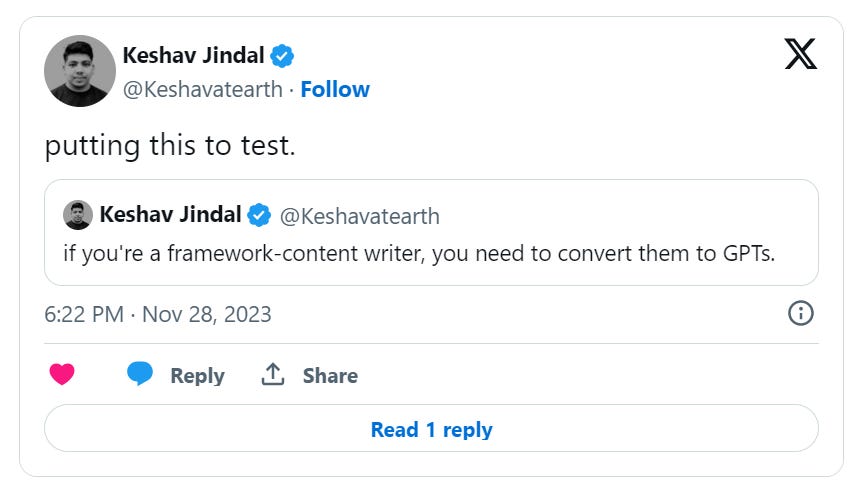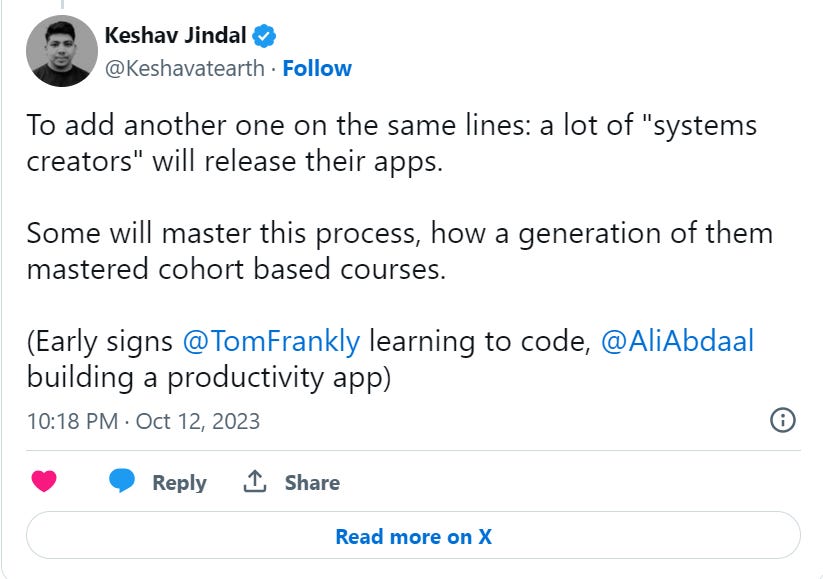Why I created Resume GPT
Framework to GPT is a secret goldmine for creators
Open AI’s GPTs launched on 6th November, just 3 weeks back. These are custom chatbots that can let ChatGPT behave in a certain way. I had two major opinions about GPTs
More people will create their own GPTs.
Creators should convert framework threads to actionable GPTs.
The first one is hard to verify. I have 3 that I use privately. But to be Devil’s Advocate, there are many public GPTs with more than 10,000+ chats within these 3 weeks (despite the Open AI drama and holidays).
For the 2nd statement, I am extra optimistic because of the success of public GPTs. This is different from dumping your content into a text file and letting users chat with it. It’s what I call “Framework to GPT” (more on this below).
While I kept mentioning that opinion on socials, I couldn’t test the “Frameworks to GPTs” aspect much (again, the OpenAI drama is the culprit). Finally, I did with ResumeGPT.
Creating Resume GPT
I had a Udemy course with me from a few years ago: The Ultimate Resume Makeover by Waqas Hassn. I took the transcripts from the 20 lessons of the course ending up with about 25k words of transcripts. But I couldn't use the transcripts as they are.
The custom instructions in GPTs can only take about 6000 words.
The transcripts need to be converted to instructions.
ChatGPT to the rescue. I summarized the lesson-wise transcripts into instructions with a simple prompt.
You're a framework/SOP creator. I'll give you my thoughts about resumes and your job is to compress the content into instructions for my employees who will be grading/reviewing resumes.
reply OK if you got it.
I combined them in a mega prompt into a doc. Those ended up being 900 words. So the length is solved.
Next comes testing if the instructions actually work. As expected, they don’t.
What?… They don’t?…
Yup.
For the first message, it just repeated the instructions to me. Then it hit me. You need to tell the GPT that it is Resume GPT and it has to follow these instructions. So the prompt split into two parts: Behaviour and Instructions.
Then the usual prompt engineering to get more fun responses, yelling in caps to not reveal the framework (which didn’t work) and further summarizing instructions. Let me know if you want a more detailed “How I built” post too.
After an hour or so of tweaking, I was happy with the results on my resume and I posted on X.
So, does it work?
Yup. Better than a few I tried with their “free trials.” Here’s the result for a sample resume I picked off a random Google result. And my boi does a good job.
ChatGPT kept giving up as I was using it in three multiple tabs. Resume GPT can be improved in multiple ways. Right now it’s only got less than 2 hours of work put into it. The secrecy can be improved. More “features” like matching with a job description can be introduced from a software perspective. Let’s see if I get the time to improve it further.
But my goal isn’t to make the best Resume GPT here. It’s to test my opinion of “Framework to GPT.” And with just a few hours of building, I think it’s safe to say YES, the opinion stands.
Tell me more about “Framework to GPT”
Users don’t want to think. Frameworks do the thinking for your user, putting them in a certain workflow to get them closer to their goal. There are two ways of delivering a framework to the user: Content and Software.
Channelling my inner Naval to highlight: software has more leverage than content. Engaging users via content is becoming increasingly hard. Some of the top “framework” creators are already gearing towards making software businesses around their content or adding software to their content.
If you scroll through the tweet linked above, it started with my tweet about the general shift from “content marketing” to “tool marketing.” Tools>>Content has always been true. Spotify is bigger than any single artist. The problem is that making tools is also much harder than making content.
GPTs are an easy way to convert frameworks into software. You don’t need to know code. You just need to understand what you’re saying enough to turn it into a workflow. You don’t need to mimic the complexity of full-fledged apps. You just need your reader/viewer to implement a basic workflow with the thinking process abstracted away.
For example, ResumeGPT takes the framework from a course creator and turns it into an automatic implementation.
Why should creators make GPTs?
The creator world works in trends. The last two “money-making” trends that caught on were CBC—Cohort Based Courses (on the decline) and FMCG—Fast Moving Consumer Goods (still climbing but near the peak). I believe the next trends are going to be AI Tools and Human Connections. GPTs are the earliest version of AI Tools you can build and often, it pays to be early.
More creators will be flocking towards creating GPTs anyway. Much of this rush would be limited to simple “chat with my articles/video transcripts” chatbots. It’d be the new way of selling their likeness (the previous attempt was selling merch). But creators have the best library of frameworks with user feedback on what works. CBCs at their core were “Framework to Courses.” CBCs made more money for more creators than merch did.
And I’ll be honest, creating a GPT that you can monetize from the get-go will be hard (though not impossible). Where I’m more hopeful of GPTs creating value is in the lead capture for creator funnels.
I’ve tons of ideas on how creators can use GPTs: different ways to make GPTs for their content, placing them into money-making funnels, making it suitable for upcoming GPT store and more, it’s literally an experiment ground. I wrote another article on getting started with building GPTs which is more geared towards builders but DM me on Twitter (X) if you’d like to chat about it.





Love the framework to GPT idea! I used ResumeGPT and was pleased by the outcome. Would love to connect and learn how you built the GPT + best practices for prompting. 🙌
why do you think CBCs are on decline? they are quite efficient in knowledge distribution. Are you suggesting the CBCs among the distributors, the curators, are on decline.